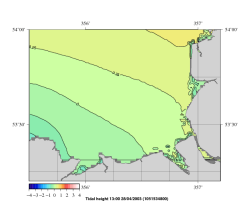GMT colour palette tables

Tidal elevation in Liverpool Bay with GMT's Haxby palette
- The format is described in the manual for makecpt. The standard palettes are shown in the GMT reference.
- Manual page for the GMT programs makecpt and grd2cpt.
- The cptutils package provides some extra tools for manipulating cpt files.
- MapAbility's CPT Designer is a Windows GUI application for the creation and editing of cpt files (commercial with free trial period).
CSS3 gradients
- The W3C has recently defined a gradient format for the latest revision of the cascading style sheet standard.
- The standard is largely based on mozilla's version of CSS gradients, their documentation can be found here.
GIMP gradients
- The GIMP is an open-source drawing application with a fine gradient editor and a selection of built-in gradients, also available here.
- The gradient format is discussed in this thread on the gimp-developer mailing list.
Gnuplot palettes
- Gnuplot is a portable command-line driven graphing utility under active development since 1986.
- Gnuplot uses colour palettes specified by formulae or data-files in a number of colour-spaces, using the “set palette” command. See, for example, the pm3d, pm3dcolors and hidden2 demos.
- The gpf files on cpt-city are Gnuplot palette files in the RGB colour-space. See “help set palette file” in the Gnuplot shell for more information.
SAO colour maps
-
External SAO colour maps can be used in
DS9
either from
the command line (see the
-cmapoption) or from thecolormap parametersdialogue in thecolormenu in the GUI. In the latest beta version of DS9 one can browse cpt-city directly from colormap parameters → file → download colormap. Clicking on an "sao" link loads the map directly into the program. - The CHiPS plotting system for the Chandra X-ray observatory also uses SAO format colour maps.
- The SAO format is simple ASCII with independent RGB channels of linear splines. More details on the format can be found on the SAOimage site.
SVG gradients
- The W3C has defined an XML-based gradient format as a part the SVG vector graphics format.
- The open clipart library contains a number of SVG gradients (translated here).
POV-Ray colour maps
- The free ray-tracing program POV-Ray supports colour-maps as part of its complex pigment type.
- The online documentation for version 3.6.1 describes the syntax and has several coding examples.
R
- R is an open-source statistics package implementing advanced statistical algorithms and with a powerful and intutive graphics capability.
- Sergio Ibarra-Espinosa of the Universidade de São Paulo maintains an R package making the gradients of cpt-city available in R graphics scripts.
- Development of the package takes place in the GitHub repository, which also contains documentation and examples of usage.
GRASS
- Users of the GRASS GIS system can import the cpt files on cpt-city using the r.cpt2grass script from the GRASS Add-ons collection.
- Information on the use of colour maps in GRASS can found on Hamish Bowman's Peripheral Visionary pages.
IDL
- Michael Galloy has written an IDL routine to read a cpt file and return it as a 256 by 3 color table array.
Matlab, Octave
- One can use cpt files in the Matlab and Octave linear algebra packages with the colormap_cpt m-file by Thijs Damsma, part of the OpenEarthTools collection.
- The MathWorks hosts a CPT for Matlab package which allows cpt files to be loaded as Matlab colour-maps.
Python
- GMT cpt files can be loaded dynamically into Python/matplotlib using James Boyle's gmtColormap.py script.
- Incomplete but possibly interesting: Robert Smallshire's pycpt aims to provide comprehensive cpt support for Python.
- See also Jonas' package of the same name.
- In 2025, Professor L. Seydoux of L'institut de physique du globe de Paris at Université Paris Cité released pycpt-city, a Python package including schemes from the archive and simplified access to them, in particular for Matplotlib.
Medcon
- The open-source medical image viewer medcon uses a simple 256 level lookup table (LUT) for its colour gradients.
- The GIMP gradients on cpt-city can be converted to the LUT format with the gimplut program, part of the cptutils package
Paint Shop Pro
-
Paint Shop Pro uses version 3 of the grd format for its gradients.
Typically the files have the extensions
.PspGradientor.jgd. - The format is undocumented but rather simple: a technical description can be found here.
ee also the general links page.